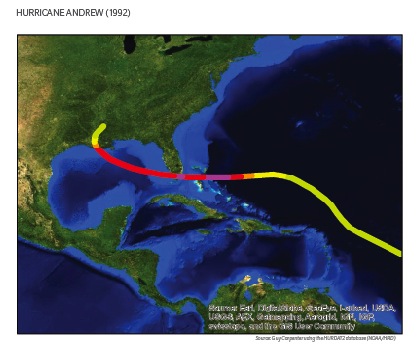
Hurricane Andrew made U.S. landfall in 1992. The storm originated from a tropical wave and experienced disruptive wind shear until arriving in the West Atlantic. Once in the West Atlantic, Andrew first reached hurricane status on the morning of August 22 and then developed explosively into a Category 5 hurricane on the Saffir-Simpson scale with maximum sustained winds of 165 mph when it made landfall on Florida's coast.
Andrew made a second landfall in coastal Louisiana with maximum sustained winds of 115 mph, a Category 3 hurricane.

The hurricane produced storm surge estimated near 17 feet near Burger King International headquarters on Biscayne Bay, Florida. Damage was severe to complete across Dade County, Florida and complete devastation in the Bahamas.
Estimated economic losses stand at USD58.5 billion in 2010 dollars, correcting for wealth and inflation (1).
This was a very quiet season under a decaying El Niño year, with only four hurricanes in the Atlantic basin, one of which made U.S. landfall.
Note:
1. Blake, E.S., Landsea, C.W. and Gibney, E.J., 2011: The Deadliest, Costliest, and Most Intense United States Tropical Cyclones From 1851 to 2010. National Weather Service. NOAA Technical Memorandum NWS NHC-6.